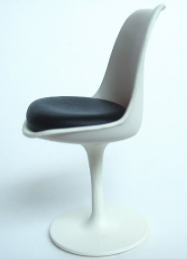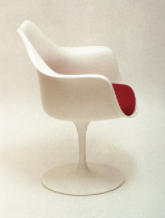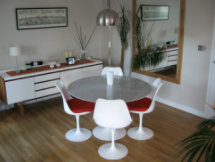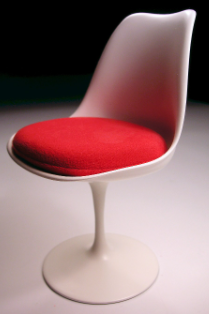The Tulip Chair was designed by Eero Saarinen in 1955 and 1956 for the Knoll Company of New York City. It was designed primarily as a chair to match the complementary dining table. The chair, a classic of industrial design, has the smooth lines of modernism and was experimental with materials for its time.

Image source: https://en.wikipedia.org/wiki/Knoll_(company)#/media/File:Tulip_chair.jpg
How was the Tulip Chair conceived and Why?

Image source: https://search.creativecommons.org/photos/1afb3ee4-b366-43d7-ab65-bd1143b73948
Like many contemporary architects, Eero Saarinen was challenged by furniture design, especially the chair, which presents aesthetical and structural problems that are particularly difficult to solve. Notably, Saarinen’s objective was to resolve the “ugly, confusing, unrestful world” underneath chairs and tables, and in order to do that, he designed a chair that could be “all one thing again”. The Tulip Chair, with its only leg, is therefore an accomplishment of modern design and a timeless addition to the furnishing industry.

Image source: https://search.creativecommons.org/photos/13b2388b-100a-4d3f-b3fd-670095b00ed3
“The undercarriage of chairs and tables in a typical interior makes an ugly, confusing, unrestful world. I wanted to clear up the slum of legs. I wanted to make the chair all one thing again.”
A Bridge Between Stylistic Eras
The Tulip Chair is often considered “space age” for its futuristic use of curves and artificial materials. It is in fact a piece of furniture that can be seen as a bridge between two artistic currents: the sober International Style and the whimsical, eccentric postmodernism. Likewise, the chair sets new standards for modern design, being an accomplished effort in clarifying form.

Image source: https://search.creativecommons.org/photos/a6bfb037-f069-425b-9e21-d74751c9a39e by El gran sueño – Asturias
Patent and Versions
Designed in 1955, Saarinen was awarded a patent for the Tulip Chair only five years after, in 1960. He realised two versions of the chair: one with the armrests and one without them. The former falls under the name of “Tulip Arm Chair”, while the latter is called “Tulip Armless Chair”. Each of these two versions has also a variation with cushions both on the seat and the backrest.

Image source: https://en.wikipedia.org/wiki/Tulip_chair#/media/File:Tulip_med.jpg
Which are the Materials of the Tulip Suite?
Saarinen had hoped to produce the chair as a one piece unit made entirely of fiberglass, but this material was not able to support the base, and prototypes were prone to breakage. As a result, the base of the Tulip Chair is of cast aluminum with a rilsan-coated finish to match the upper shell, giving the appearance of a single unit. The upper shell is molded fiberglass, with a reinforced, plastic bonded finish. The upholstered foam cushion is removable with zippered cover and Velcro fastening.

Image source: https://en.wikipedia.org/wiki/Eero_Saarinen#/media/File:Saarinen_Tulpanstolen.jpg
Data Sheet
- Designer: Eero Saarinen;
- Year of design: 1955-1956;
- Manufacturer: Knoll;
- Provenance: USA.
Info sources:
https://en.wikipedia.org/wiki/Tulip_chair
https://www.knoll.com/product/tulip-arm-chair
https://www.britannica.com/biography/Eero-Saarinen
https://knoll.com/product/tulip-arm-chair?section=design
https://knoll.com/product/tulip-armless-chair?section=design
